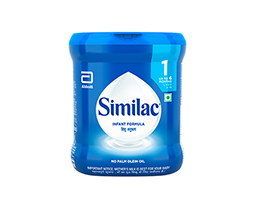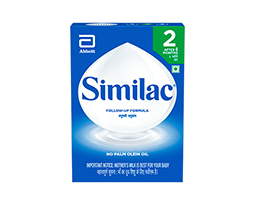Hydrolized corn starch, soy protein isolate (15.61%), edible vegetable oil (high oleic sunflower oil, coconut oil, soy oil), sucrose, MINERALS***, acidity regulator (potassium citrate), VITAMINS**, I-methionine, taurine, l-carnitine tartrate. Contains Soy
Similac Isomil
Similac Isomil
- Product Description
-
Similac Isomil® is formulated specially for infant feeding needs from birth. Similac Isomil® is a soy-based milk free, lactose free spray dried infant formula, to meet the special nutritional needs of infants suffering from Diarrhea, Cow’s Milk Protein Allergy (CMPA) & lactose intolerance.
The lactose free soy formula helps infants recover faster from diarrhea1-3
The inherent nucleotide in Similac Isomil® reinforces gut immunity4 & helps reduce incidences of diarrhea5.
Similac Isomil® offers unique dual carbohydrate blend that helps restore gut health.
Nutrients
| Approximate Composition | Powder (per 100 g) | Standard Dilution (per 100 ml) |
|---|---|---|
| Energy | 496 kcal 2073 kJ | 65 kcal 273 kJ |
| Protein | 13.20 g | 1.74 g |
| Fat | 27.00g | 3.55g |
| Saturated Fatty Acids | 11.83 g | 4.12 g |
| Monounsaturated Fatty Acids | 9 g | 1.2 g |
| Polyunsaturated Fatty Acids | 4.2 g | 0.56 g |
| Transfat | 0.5 g | 0.17 g |
| Cholesterol | 1.10 mg | 0.38 mg |
| Linoleic Acid | 4.0 g | 0.53 g |
| Carbohydrate | 50.00 g | 6.58 g |
| Total Sugars | 15 g | 2.0 g |
| Added Sugars | 15 g | 2.0 g |
| Taurine | 27 mg | 3.6 mg |
| Carnitine | 8.6 mg | 1.13 mg |
| Methionine | 38 mg | 5.0 mg |
| VITAMINS | ||
| Vitamin A (from palmitate) | 480 mcg RE | 63 mcg RE |
| B-carotene | 300 mcg | 39 mcg |
| Vitamin D2 | 8.6 mcg | 1.1 mcg |
| Vitamin E | 21 IU 14 mg alpha-TE | 2.8 IU 1.9 mg alpha-TE |
| Vitamin K | 40 mcg | 5.3 mcg |
| Vitamin C | 42 mg | 5.5 mg |
| Folic Acid | 80 mcg | 11 mcg |
| Vitamin B1 | 0.4 mg | 0.05 mg |
| Vitamin B2 | 0.36 mg | 0.05 mg |
| Vitamin B6 | 0.24 mg | 0.03 mg |
| Vitamin B12 | 1.8 mcg | 0.24 mcg |
| Niacin | 4.2 mg | 0.55 mg |
| Pantothenic Acid | 3.0 mg | 0.39 mg |
| Biotin | 20 mcg | 2.6 mcg |
| Choline | 48 mg | 6.3 mg |
| MINERALS | ||
| Sodium | 195 mg | 26 mg |
| Potassium | 400 mg | 53 mg |
| Chloride | 275 mg | 36 mg |
| Calcium | 425 mg | 56 mg |
| Phosphorus | 304 mg | 40 mg |
| Magnesium | 33 mg | 4.3 mg |
| Iron | 6.2 mg | 0.82 mg |
| Zinc | 3.5 mg | 0.46 mg |
| Manganese | 0.24 mg | 0.03 mg |
| Copper | 297 mcg | 39 mcg |
| Iodine | 61 mcg | 8.0 mcg |
| Selenium | 14 mcg | 1.8 mcg |
Preparation
PREPARING A SINGLE FEEDING:
- Thoroughly wash feeding bottle nipple, cap and all utensils to be used in preparing the feeding.
- After rinsing soap from the utensils, boil them for five minutes
- In a separate pan, boil water to a rolling boil for 5 minutes and allow it to cool.
- Pour the correct amount of warm, previously boiled water into the sterilized feeding bottle.
- Fill scoop by pressing against the tin, then scrape level with a clean knife blade. Use only the scoop enclosed in this tin to measure Similac Isomil®.
- Add one scoop of Similac Isomil (8.7g) to each 60 ml of water in bottle.
- Mix until completely dissolved.
- Test temperature and feed. Discard unused formula.
If the preparation is made for more than one feeding then it must be refrigerated and used within 24 hours. Once feeding begins use within 1 hour or discard
Product Details
400gm Tin Pack (Up to 24 months)
Directions for Use
Use as directed by your physician. Repeated use of improperly prepared formula could cause illness If you prepare more than one feeding it must be refrigerated and used within 24 hours. Once feeding begins use within 1 hour or discard
Storage Condition
The contents of this can will make approximately 3 L of formula when mixed as directed. Store in a cool and dry place in an air-tight container (not in the refrigerator). Store unopened tin under normal room conditions. Once this tin is opened, contents should be used within three weeks or within expiry date whichever is earlier. NOTE: Prepared formula may also be fed from a cup, or mixed with cereal or other solid foods.
Important Notice
MOTHER’S MILK IS BEST FOR THE BABY
Breastfeeding provides the best nutrition and protection from illnesses of infants. For infants, breast milk is all that is needed for the first 6 months. Breastmilk is the best and most economical food for baby. Warning / Caution: Infant milk substitute is not the sole source of nourishment of an infant. Careful and hygienic preparation of infant milk substitute is most essential for health. Lactose- free infant milk substitute should only be used in case of diarrhea due to Lactose intolerance. Lactose- free infant formula should be withdrawn, if there is no improvement in symptoms of intolerance.
Continued use of infant milk substitute should not be recommended to avoid any difficulties in reverting to breastfeeding of infants after a period of feeding by infant milk substitute. In the event of recommending infant milk substitute in addition to breastmilk or its replacement during the first 6 months, keep the costs in mind. Un-boiled water, un-boiled bottles or incorrect dilution can make a baby ill. Always advise to follow instructions exactly. Unnecessary introduction of partial bottle-feeding or other foods and drinks will have negative effect on breastfeeding.
Characteristics of breastmilk: Immediately after delivery, breastmilk is yellowish and sticky. This milk is called Colostrum, which is secreted during the first-week of delivery. Colostrum is more nutritious than mature milk because it contains more protein, more anti-infective properties, which are of great importance for the infant’s defence against dangerous neo-natal infections. It also contains higher levels of Vitamin “A”.
Advantages of breastfeeding:
(A) Breastmilk is a complete and balanced food and provides all the nutrients needed by the infant; (for the first six months of life)
(B) Breastmilk has anti-infective properties that protect the infants from infection in the early months;
(C) Breastfeeding is much cheaper than feeding infant milk substitutes as the cost of extra food needed by the mother is negligible as compared to the cost of feeding infant milk substitutes;
(D) Breastmilk is always available;
(E) Breastmilk needs no utensils or water (which might carry germs) or fuel for it’s preparation;
(F) Mothers who breastfeed usually have longer periods of infertility after child birth than non-lactators.
Management of breastfeeding, as under:
i. Breastfeeding
a.) Immediately after delivery enables the contraction of the womb and helps the mother to regain her figure quickly.
b.) Is successful when the infant suckles frequently and the mother wanting to breastfeed is confident in her ability to do so.
ii. In order to promote and support breastfeeding the mother's natural desire to breastfeed should always be encouraged by giving, where needed, practical advice and making sure that she has the support of her relatives.
iii. Adequate care for the breast and nipples should be taken during pregnancy.
iv. It is also necessary to put the infant to the breast as soon as possible after delivery.
v. Let the mother and the infant stay together after the delivery, the mother and her infant should be allowed to stay together (in hospital, this is called "rooming- in").
vi. Give the infant Colostrum as it is rich in many nutrients and its anti-infective factors protect the infants from infections during the few days of its birth.
vii. The practice of discarding Colostrum and giving sugar water, honey water, butter or other concoctions instead of Colostrum should be very strongly discouraged.
viii. Let the infants suckle on demand.
ix. Every effort should be made to breastfeed the infants whenever they cry.
x. Mother should keep her body and clothes and that of the infant always neat and clean.
Abbott Healthcare Pvt Ltd,
Floor 17th, Godrej BKC, Plot C-68, G-Block, Bandra Kurla Complex, Near MCA Club, Bandra (East), Mumbai 400051. India
This information is for healthcare professionals only.
References
1. Allen UD, et al. Acta Paediatr. 1994;83(2):183-7.
2. Santosham M, et al. Pediatrics. 1985;76:292-298.
3. Santosham M, et al. Pediatrics. 1991;87(5);619-622.
4. Aaron L, et al. IMAJ. 2000;2:772-774.
5. Singhal A, et al. Am J Clin Nutr. 2008;87(6):1785-1792.
6. Data on File: SI Promotional Claims April 2019. C MARC India, April 2019.
7. Heine RG, et al. World Allergy Organ J. 2017;10(1):41.
RELATED PRODUCTS

Similac Stage 1
Similac Stage 1 is a scientifically formulated to meet the nutritional requirements for babies up to 6 months of age. Similac is a cow’s milk-based, iron-fortified feeding formula with nutrient composition clinically shown to support infants’ growth and development similar to that of the breastfed infants. SIMILAC is formulated as per standards laid down by Bureau of Indian Standards (BIS).

Similac Stage 2
Similac Stage 2 is a scientifically formulated to meet the nutritional requirements for babies after 6 months of age. Similac is a cow’s milk-based, iron-fortified feeding formula with nutrient composition clinically shown to support infants’ growth and development similar to that of the breastfed infants. SIMILAC is formulated as per standards laid down by Bureau of Indian Standards (BIS).

Similac Stage 3
Similac is a cow’s milk-based, iron-fortified feeding formula with nutrient composition clinically shown to support infants’ growth and development similar to that of the breastfed infants. SIMILAC is formulated as per standards laid down by Bureau of Indian Standards (BIS).
RELATED CONTENT

Childhood Malnutrition – A Global Concern
Childhood malnutrition of every form, including undernutrition (wasting, stunting and underweight), micronutrient deficiencies, as well as overweight and obesity, consists a triple burden of disease, especially for low- and middle-income countries, and is one of the leading causes of poor health in children.

Boost Their Performance - Right Nutrients at the Right Age
Childhood and adolescence are nutritional critical points due to rapid growth and development. It is characterized by an increase in cell number and a concerted and coordinated change in cell/tissue/organ characteristics and functions. Longitudinal growth of the skeleton is the most obvious feature accompanied by the growth and maturation of the muscles, the internal organs, the reproductive system and the central nervous system. This developmental growth stage of the child is predetermined by his activity levels which depend on his physical and mental stamina.

Child Growth Concerns
Linear growth in early childhood is a strong marker of healthy growth and is also closely linked with child development in several domains including cognitive, language and sensory-motor capacities.
IN-ISO-JUL-2022-1656995324



